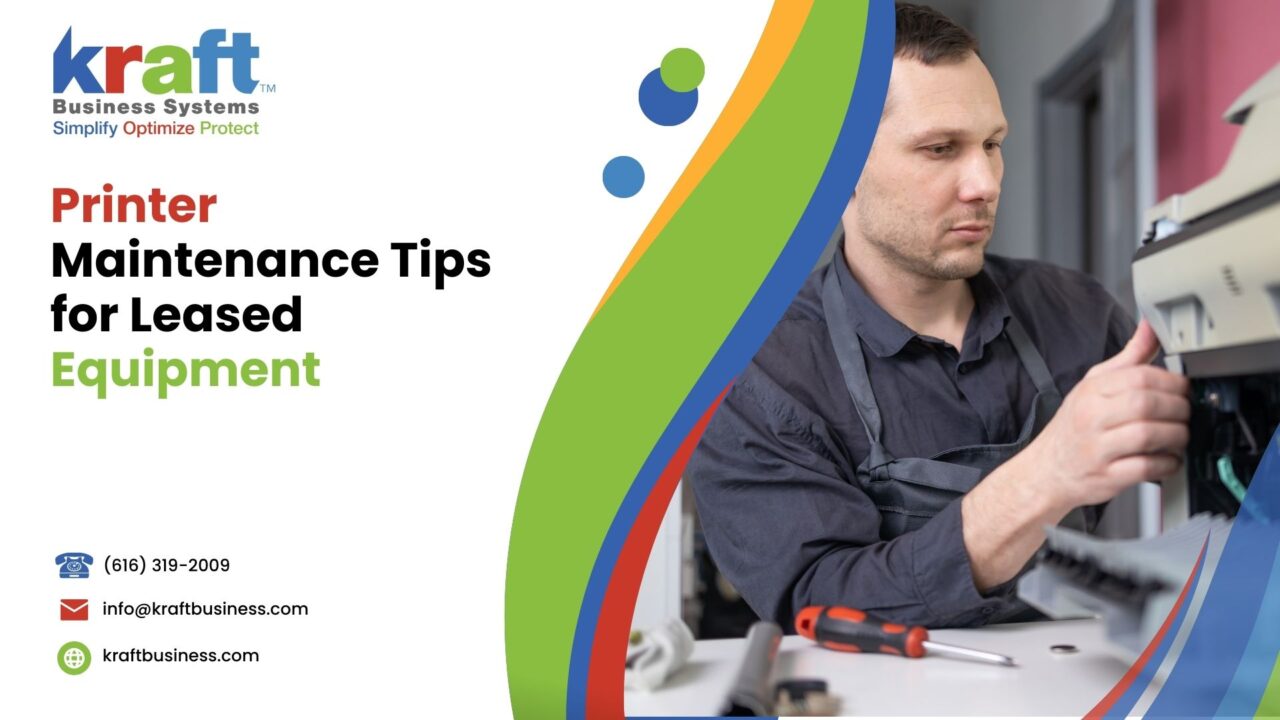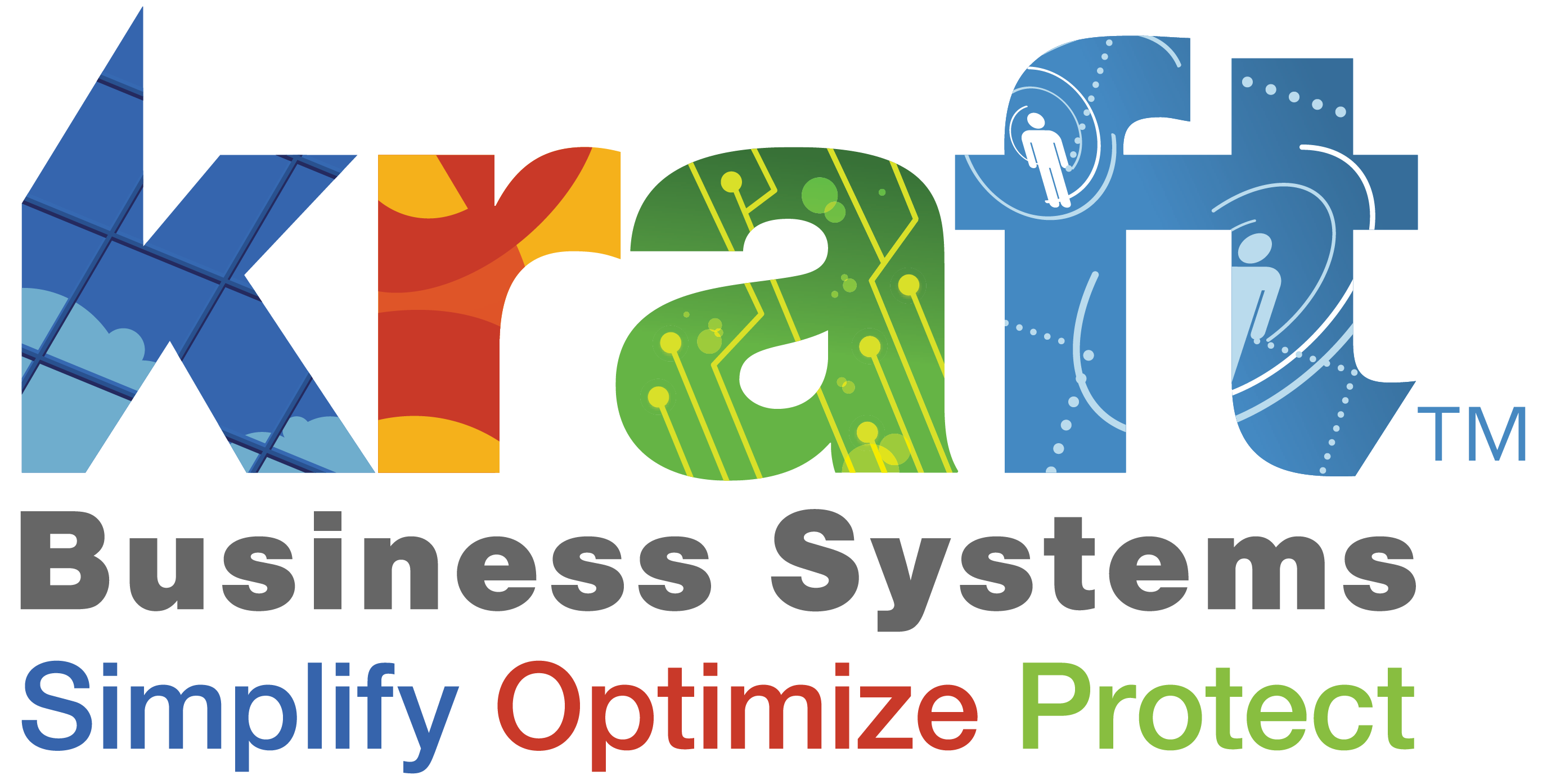Printer maintenance is crucial for ensuring the longevity and performance of your equipment, especially when it comes toleased printers. Regular maintenance not only helps in preventing costly repairs but also ensures high-quality prints.
This guide will provide you with essential printer maintenance tips, focusing on different types of printers and the necessary tools to keep your printer running smoothly.
Advanced Printer Maintenance Strategies
Understanding Printer Maintenance
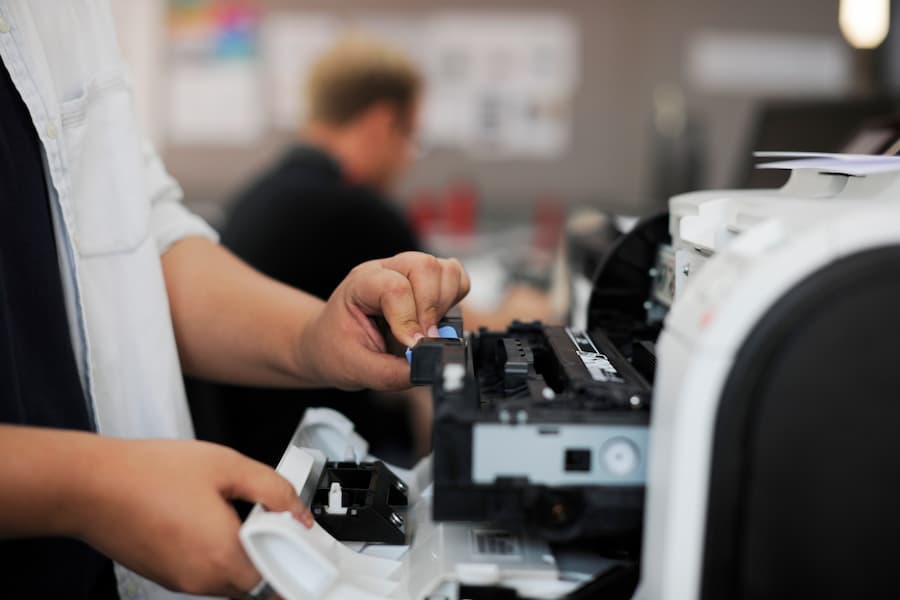
Printer maintenance involves a series of regular tasks designed to keep your printer in optimal condition. These tasks include cleaning, replacing consumables, and troubleshooting common issues. Regular maintenance is essential for extending the life of your printer and maintaining print quality.
Advanced Printer Maintenance Strategies
Key Components of Printer Maintenance
Printer Models and Types
Understanding the specific maintenance needs of your printer model is vital. Different types of printers, such as inkjet and laser printers, have unique maintenance requirements.
Inkjet Printer Maintenance
Inkjet printers require regular attention to ensure their print heads and nozzles remain unclogged. Common issues with inkjet printers include dried ink and print head blockages. Regular use and cleaning cycles can prevent these problems.
Laser Printer Maintenance
Laser printers use toner and have different maintenance needs compared to inkjet printers. Regularly cleaning the toner cartridges and fuser unit is essential to avoid print quality issues and mechanical failures.
Advanced Printer Maintenance Strategies
Essential Printer Maintenance Tips
Cleaning the Printer
Keeping your printer clean, both inside and out, is one of the most important maintenance tasks. Dust and debris can accumulate and cause various issues, including paper jams and poor print quality.
Inside Cleaning
Use compressed air to remove dust from inside the printer. Focus on areas like the print head, rollers, and internal compartments. Ensure you unplug the printer before cleaning to avoid any electrical hazards.
Outside Cleaning
Wipe the exterior of the printer with a lint-free cloth. Avoid using harsh chemicals; instead, use a solution of isopropyl alcohol and water to clean the surface gently.
Maintaining Print Quality
High-quality prints depend on the condition of your printer. Regular maintenance helps in maintaining print quality by ensuring that all components are functioning correctly.
Steps to Maintain Print Quality
- Perform regular print head cleaning cycles.
- Run a nozzle check to ensure nozzles are unclogged.
- Use high-quality ink and toner cartridges.
Handling Ink and Toner
Proper handling and storage of ink and toner cartridges are crucial to prevent leaks and ensure consistent print quality.
Storing Ink and Toner
Store ink and toner cartridges in a cool, dry place. Avoid exposing them to extreme temperatures, which can cause the ink to dry out or the toner to clump.
Replacing Cartridges
Replace ink and toner cartridges as needed. Follow the manufacturer’s instructions for replacing cartridges to avoid damaging the printer.
Advanced Printer Maintenance Strategies
Maintenance Kit and Tools
Having the right tools and maintenance kits can make printer maintenance more manageable. These kits typically include cleaning supplies and replacement parts necessary for routine upkeep.
Essential Tools for Printer Maintenance
- Compressed air for dust removal.
- Lint-free cloths for cleaning surfaces.
- Isopropyl alcohol for disinfecting and cleaning print heads.
Recommended Maintenance Kits
Different printers may require specific maintenance kits. Check with the manufacturer or supplier for recommended kits tailored to your printer model.
Advanced Printer Maintenance Strategies
Regular Maintenance Tasks
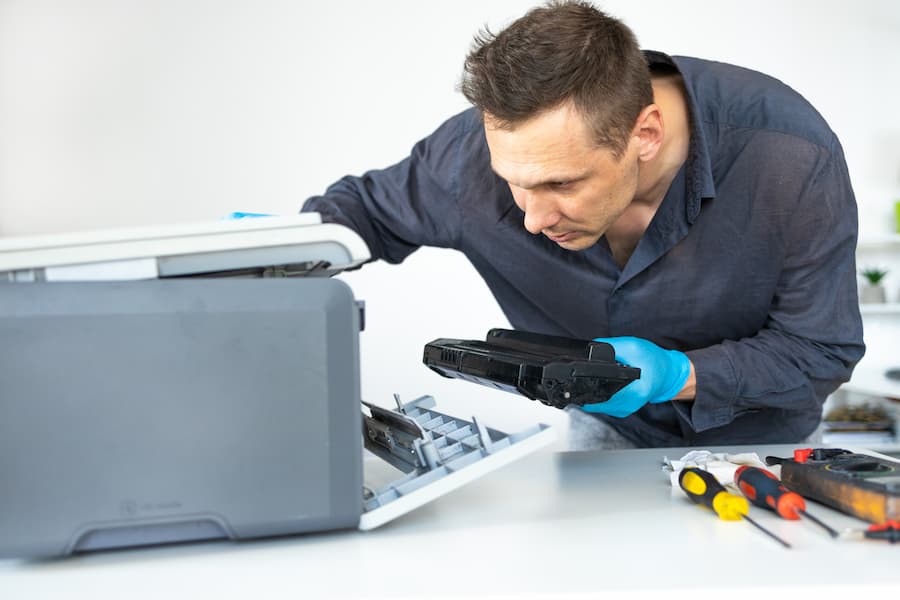
Performing regular maintenance tasks is essential to keep your printer in top condition. These tasks should be scheduled based on the printer’s usage and operating environment.
Routine Tasks to Keep Your Printer Running Smoothly
- Clean print heads and nozzles regularly.
- Check and clean the rollers to prevent paper jams.
- Ensure that the printer’s firmware is up to date.
Importance of Scheduling Maintenance
Set a regular maintenance schedule to stay on top of these tasks. This proactive approach can prevent issues before they become major problems and help extend the life of your printer.
Advanced Printer Maintenance Strategies
Troubleshooting Common Issues
Despite regular maintenance, printers can still encounter issues. Knowing how to troubleshoot common problems can save time and prevent costly repairs.
Identifying and Fixing Common Printer Problems
- Paper jams: Clear jams carefully to avoid damaging the printer.
- Poor print quality: Clean the print heads and ensure cartridges are correctly installed.
- Error messages: Refer to the printer manual or manufacturer’s website for guidance.
Preventing Costly Repairs
Regular maintenance and timely troubleshooting can prevent minor issues from becoming significant, costly repairs. Maintaining a log of maintenance activities can help identify recurring problems and address them promptly.
Advanced Printer Maintenance Strategies
Advanced Printer Maintenance Strategies
Continuing from the basics, advanced printer maintenance strategies focus on detailed cleaning procedures, handling specific printer brands, and extending the printer’s lifespan. Proper maintenance ensures that your printer remains reliable and efficient, minimizing downtime and improving print quality.
Detailed Cleaning Procedures
Cleaning Print Heads and Nozzles
Print heads and nozzles are critical components of inkjet printers. Over time, they can become clogged with dried ink, leading to poor print quality and streaks. Regular cleaning is essential to maintain optimal performance.
Step-by-Step Guide to Cleaning Print Heads
- Preparation: Turn off the printer and unplug it. Remove the ink cartridges and place them on a clean, dry surface.
- Cleaning Solution: Use a mixture of distilled water and isopropyl alcohol. Avoid tap water as it can contain impurities that may clog the nozzles.
- Cleaning Process: Dip a lint-free cloth or swab in the cleaning solution and gently wipe the print heads. For stubborn clogs, you may need to soak the print heads in the solution for a few minutes.
- Drying: Allow the print heads to dry completely before reassembling the printer. Reinstall the ink cartridges and run a cleaning cycle to ensure everything is working correctly.
Cleaning Printer Rollers
Printer rollers play a vital role in feeding paper smoothly through the printer. Dust and debris can accumulate on the rollers, causing paper jams and misfeeds.
Importance of Roller Maintenance
Regularly cleaning the rollers ensures that paper is fed correctly, preventing jams and ensuring smooth operation.
How to Clean and Maintain Printer Rollers
- Access the Rollers: Open the printer’s access panel to locate the rollers.
- Cleaning Solution: Use a lint-free cloth dampened with isopropyl alcohol.
- Cleaning Process: Gently wipe the rollers, turning them manually to clean the entire surface. Avoid using too much pressure, as this can damage the rollers.
- Reassembly: Once the rollers are clean and dry, close the access panel and test the printer by printing a few pages.
Advanced Printer Maintenance Strategies
Maintenance for Specific Printer Brands
Epson Printer Maintenance Tips
Epson printers are known for their high-quality prints and reliability. However, they require specific maintenance to perform at their best.
Specific Tips for Maintaining Epson Printers
- Firmware Updates: Regularly check for firmware updates from Epson to ensure your printer has the latest features and fixes.
- Cleaning Cycles: Run regular cleaning cycles using the printer’s built-in utility to keep the print heads clear.
- Quality Settings: Use the appropriate print quality settings for your tasks to balance print quality and ink usage.
HP Printer Maintenance Tips
HP printers are widely used in both home and office environments. Maintaining these printers involves a few specific steps to ensure they remain functional and efficient.
Specific Tips for Maintaining HP Printers
- Use Genuine HP Supplies: Use genuine HP ink and toner cartridges to prevent compatibility issues and ensure the best print quality.
- Environment Control: Keep the printer in a stable environment, avoiding extreme temperatures and humidity that can affect performance.
- Regular Cleaning: Follow HP’s guidelines for cleaning the printer, including the print heads, rollers, and internal components.
Advanced Printer Maintenance Strategies
Extending Printer Lifespan
Tips to Extend the Life of Your Printer
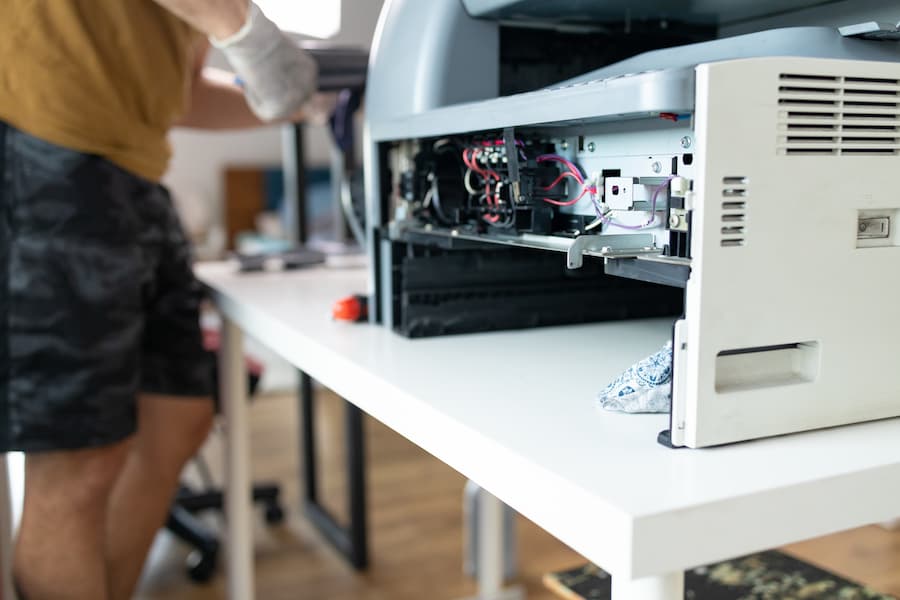
Extending the lifespan of your printer requires consistent and proactive maintenance. By taking care of your printer, you can avoid frequent breakdowns and ensure it remains reliable over the long term.
Importance of Proper Maintenance to Avoid Costly Repairs
Regular maintenance not only extends the life of your printer but also helps in preventing costly repairs. Addressing minor issues promptly can prevent them from developing into major problems.
- Regular Use: Use your printer regularly to keep the ink flowing and prevent the print heads from drying out.
- Scheduled Maintenance: Create a maintenance schedule that includes regular cleaning, checking for firmware updates, and replacing consumables as needed.
- Environmental Control: Keep the printer in a clean, dust-free environment. Use dust covers when the printer is not in use to protect it from dirt and debris.
- Proper Handling: Handle the printer gently, especially when loading paper and replacing cartridges. Rough handling can damage internal components.
Maintaining Printers in Dusty or High-Use Environments
- Frequent Cleaning: Increase the frequency of cleaning both the interior and exterior of the printer to prevent dust accumulation.
- Protective Measures: Use dust covers and place the printer in a location with minimal dust exposure.
- Regular Inspections: Conduct regular inspections to check for dust buildup and address it promptly.
Advanced Printer Maintenance Strategies
Printer Manuals and Manufacturer Guidelines
Importance of Following Manufacturer Guidelines
Printer manufacturers provide detailed maintenance guidelines specific to each model. Following these guidelines ensures that you perform maintenance tasks correctly and avoid voiding warranties.
Utilizing Printer Manuals for Maintenance
- Reading the Manual: Familiarize yourself with the printer manual and keep it handy for reference.
- Manufacturer Support: Use the support resources provided by the manufacturer, including online tutorials and customer service.
- Warranty Considerations: Follow the manufacturer’s maintenance recommendations to maintain the warranty coverage.
Advanced Printer Maintenance Strategies
What People May Also Ask
How often should I clean my printer?
The frequency of cleaning depends on how often you use your printer and the environment it’s in. For regular home use, a monthly cleaning schedule is sufficient. In high-use or dusty environments, weekly cleaning may be necessary. Regular cleaning prevents dust buildup and keeps your printer in optimal condition.
What should I do if my printer is producing streaks?
Streaks in prints are usually caused by clogged print heads or dirty nozzles. To fix this, run a cleaning cycle using the printer's utility software. If the streaks persist, manually clean the print heads with a lint-free cloth and isopropyl alcohol. Ensure that the ink cartridges are properly seated and not empty.
How can I keep my printer running smoothly?
To keep your printer running smoothly, perform regular maintenance tasks such as cleaning the print heads, replacing cartridges when needed, and ensuring the printer's firmware is up to date. Additionally, use high-quality paper and ink to prevent jams and maintain print quality.
What is a maintenance kit and do I need one?
A maintenance kit includes essential tools and replacement parts for routine printer upkeep. It typically contains items like cleaning swabs, lint-free cloths, and replacement rollers. Using a maintenance kit is a good idea to keep your printer in top condition and avoid costly repairs.
How do I clean printer rollers?
To clean printer rollers, open the printer's access panel and locate the rollers. Use a lint-free cloth dampened with isopropyl alcohol to gently wipe the rollers. Rotate the rollers manually to ensure the entire surface is cleaned. This helps prevent paper jams and ensures smooth paper feeding.
Advanced Printer Maintenance Strategies
Conclusion
Proper printer maintenance is essential for ensuring your leased equipment remains reliable and produces high-quality prints.
By following these advanced maintenance tips and regularly performing routine tasks, you can extend the life of your printer, avoid costly repairs, and maintain optimal performance. Regular maintenance not only protects your investment but also enhances the overall efficiency of your office operations.
